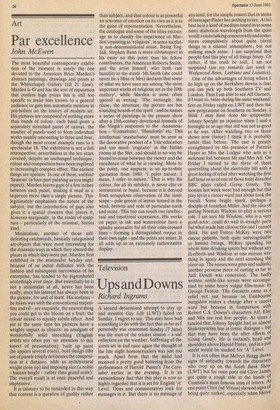Art
Par excellence
John McEwen
The most beautiful contemporary exhibition of the moment is surely the one devoted to the American Brice Marden's abstract paintings, drawings and prints at the Whitechapel Gallery (till 21 June). Marden is 43 and has the sort of reputation that confers high prices but is still too specific to make him known to a general audience or gain him automatic mention in pot-boilers on the history of modern art. His pictures are composed of nothing more than bands of colour, each band given a separately stretched panel of canvas, the number of panels used to form individual works usually amounting to three and four, though the most recent example runs to a spectacular 18. The exhibition is not a full retrospective, nevertheless in the ten years covered, despite an unchanged technique, colour and composition have been explored to increasingly complex effect. The earliest things are upstairs. In one of them, entitled `Seasons' (a four-part painting as you might expect), Marden leaves gaps of a few inches between each panel, making it read as a sequence more than a single picture. This legitimately emphasises the nature of the subject, but the introduction of gaps also gives it a spatial concern that places it, however marginally, in the realm of sculpture — particularly of the minimal, Sixties kind.
Minimalism, another of those selfdefeating catchwords, basically categorised art-objects that were most interesting for the dramatic ways in which they altered the places in which they were put. Marden first exhibited in the minimalist heyday and, because of an initial dalliance with the fashion and subsequent narrowness of his enterprise, has tended to be pigeonholed accordingly ever since. But essentially he isnot a minimalist at all, never has been really, since his interest has always been in the picture, for and of itself. His surfaces — he mixes wax with the conventional turpen tine and oil — are exquisite, the nearest thing you could get to the bloom on a fruit; the colour mixed to equally subtle effect. And yet at the same time his pictures have a weighty impact as objects: an amalgam of wonderfully solid stretching (English artists too often pay no attention to this aspect of presentation), built up paint (he applies several coats), bold design (the use of panels crisply delineates the composition at a distance, adds an architectural weight close up) and imposing size (a noble — human height — rather than grand scale). The overall result is at once peaceful and impressive.
It is salutary to be reminded in this way that content is a question of quality rather than subject, and that colour is as powerful an activator of emotion on its own as it is in the guise of representation. Nevertheless, the catalogue and some of the titles encourage us to classify the experience of Marden's painting as 'religious', in some tactfully non-denominational sense. Being English, Stephen Bann is more circumspect in his essay on this point than his fellow contributors, the American Roberta Smith, and the artist himself, who both cast humility to the winds. Ms Smith (she could never be a Miss or Mrs) declares that some of what we have seen are among 'the most important works of religious art in the 20th century', while Marden is most often quoted as writing: 'The rectangle, the plane, the structure, the picture are but sounding boards of the spirit'; and he names a series of paintings in the present show after a 15th-century devotional formula of the Virgin's responses to the Annunciation — `Conturbatio', 'Humiliatio' etc. This intellectual `masturbatio' must be seen as the decorative product of a Yale education and too much `cogitatio' in the Italian rooms at the Met, and should in no way be forced to come between the viewer and the excellence of what he is viewing. More to the point, one suspects, is an up-to-date quotation from 1980: `I paint nature. I mean, I refer to nature.' That is why his colour, for all its subtlety, is never chic or sentimental or banal, because it is derived from scrupulous observation of the landscape — pale greens of leaves turned in the wind, browns and reds of particular earth and stone. This too can touch our intellectual and emotional experience. His works on paper in ink and watercolour have a splashy sensuality for all their criss-crossed lines — forming a distinguished corpus in their own right and the prints are smart. It all adds up to an extremely authoritative display.






































 Previous page
Previous page